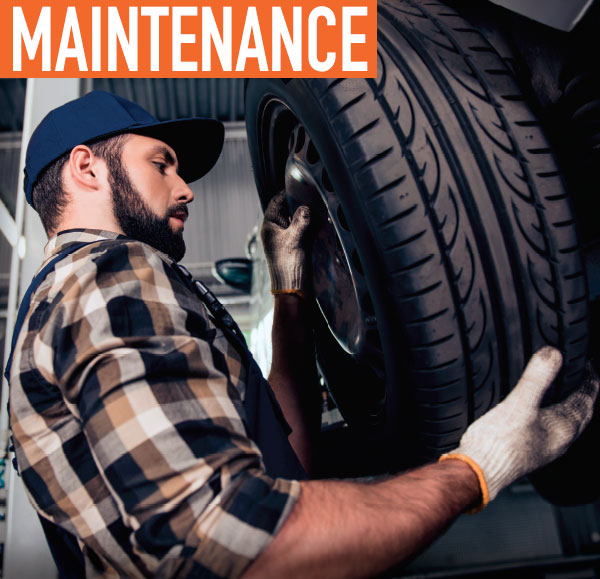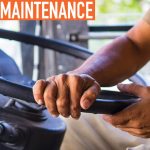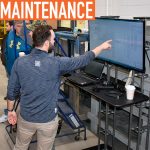Fleets leave millions of dollars on the table every year by not balancing their tires and wheels. Poor tire and wheel balance results in uneven tire wear that prematurely consigns thousands of tires to the scrap pile. Imbalanced tires and wheels are also responsible for increased wear and tear on other vehicle components and ride complaints from drivers. Additionally, improperly balanced tires and wheels have a negative effect on fuel economy. There is a simple remedy for poor tire and wheel balance, yet many fleets do not fully exploit its advantages. Many fleets believe balancing is unnecessary or have simply given up on it because traditional balancing methods do not deliver the expected benefits.
Traditional spin balancing of a tire and rim addresses the condition of the assembly only at that moment. It does nothing to address the changing condition of the tire as it wears, nor does it address the condition of wheel hub or brake drum. Those are all parts of the rotating assembly at the end of the axle and need to be balanced as a single unit. The time, money, and effort that goes into spin balancing has very little impact on the balance of the wheel over time.
It’s also quite likely that fleets are getting bad advice from tire dealers, who may suggest that balancing is unnecessary due to the high manufacturing standards of modern tires. Manufacturing processes and tolerances are such that irregularities are largely eliminated or reduced to an almost inconsequential level. While that may be true for top of the line Tier 1 and some Tier 2 tires, it may not apply to lower quality Tier 3 tires, and it certainly won’t apply to the cheap off-shore imports now flooding the North American commercial tire market.
NOT JUST THE TIRES
There are many reasons for the rotating mass at the end of an axle to be imperfectly balanced, including poor attention to detail during installation. Installers should verify that the GG ring on the tire (a raised circumferential ring located close to the bead of the tire) is centered on the full 360-degree sweep of the wheel. A failure to verify this can result in a condition known as non-centric mounting, where the rotation of the tire tread around a central axis point becomes egg-shaped.
Similarly when the wheel is fastened to the hub, it should sit evenly on all four hub pilots. If the pilots are worn, a similar non-concentric condition can result, but this is preventable with the use of stud centering sleeves. Installers should check the radial runout of the tire by placing an object as close to the tread face as possible and spinning the wheel. Any variation in the gap between the marker and the tread as the wheel rotates indicates non-concentric mounting. To avoid premature tire wear, vibration, and ride complaints from the driver, the entire wheel assembly should be remounted and properly centered.
While there are many causes of irregular tire wear from non-concentric mounting to poor vehicle alignment resulting in cupping, scalloping, wavy wear, spot wear, and flat-spotting, the result is the same: Quantities of rubber are scrubbed off the tire over time. A typical deep-tread tire loses about 30 lbs of tread rubber from the time it’s new until it’s removed at 4/32 of an inch of tread depth. Irregular wear changes the shape of the tire and by extension, the balance of the entire wheel-end assembly. This is where internal wheel balancing products such as Counteract Balancing Beads can really help.

PERMANENT SOLUTION
Unlike fixed wheel weights, balancing beads are free to move around inside the tire, repositioning themselves to where they are needed, offsetting the uneven weight distribution of worn tread. The tire is kept in balance regardless of the condition of the tread. While the beads don’t prevent wear caused by external factors such as misalignment, they mitigate additional wear resulting from imbalance as tread rubber is scrubbed away. This is especially beneficial with tires that are repositioned to drive or trailer positions to run out prior to retreading.
Since the balancing material is reusable, it can be put back into the tire when it is remounted so that the tire continues to run in a balanced condition. This promotes longer tread and casing life, smoother operation, and improved fuel economy.
Yes, tire and wheel balancing can improve fuel economy through reduced rolling resistance. It takes extra energy to roll an imbalanced tire, and that energy comes straight from your fuel tank. To date, only one balancing product is proven to improve fuel economy, and that product is Counteract Balancing Beads. The industry’s most widely accepted fuel economy test, referred to as the SAE J1321/TMC RP -1102 Type II Fuel Test was conducted twice by Counteract. The first through PAVE at Auburn University and the second by the agency known as PIT (Performance Improvement Technology). The results of both tests showed the use of Counteract Balancing Beads in all wheel positions is proven to increase fuel efficiency by 2.2%.
IMPROVE THE RIDE
While the performance benefits of balancing truck tires and wheels with an adaptive balancing product like Counteract Balancing Beads are many, the product itself is environmentally inert (unlike lead tire weights, which are now banned in several North American jurisdictions), and it will not damage the inside of the tire or void tire warranties. The product is unaffected by moisture, it will not clump inside the tire, nor will it clog the tire valve.
Fleets accustomed to seeing few if any long-term benefits to traditional spin-balancing see reduced irregular tire wear and an improvement in tire life when using an internal balancing compound like Counteract Balancing Beads.
FOR MORE INFORMATION
Find out test results and more information at www.counteractbalancing.com.
MODERN WORKTRUCK SOLUTIONS: MAY 2019 ISSUE
Did you enjoy this article?
Subscribe to the FREE Digital Edition of Modern WorkTruck Solutions magazine.





